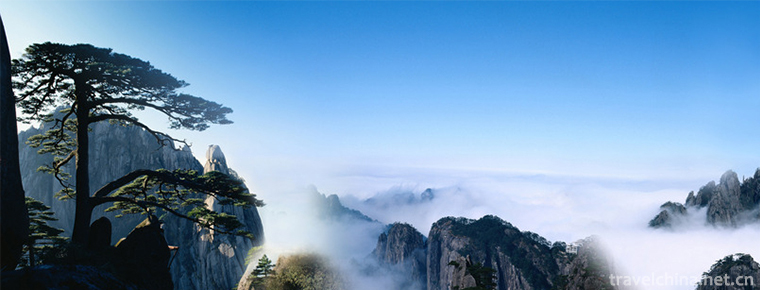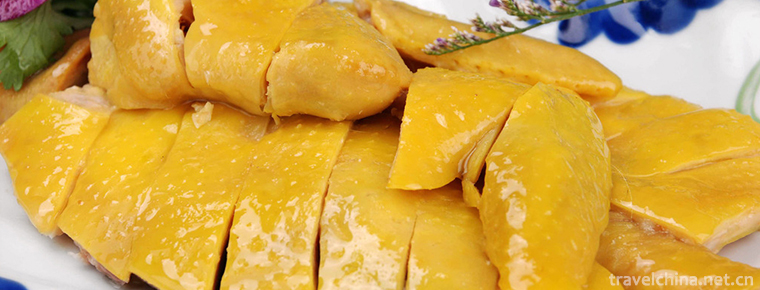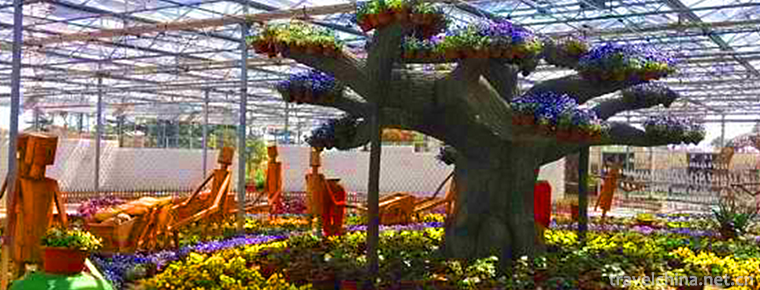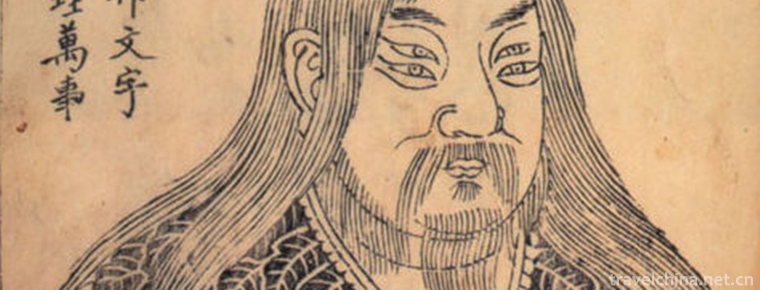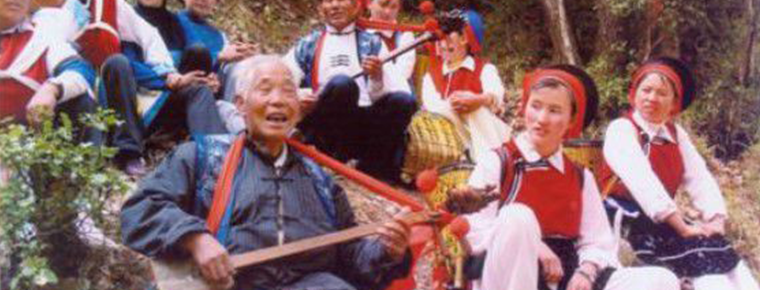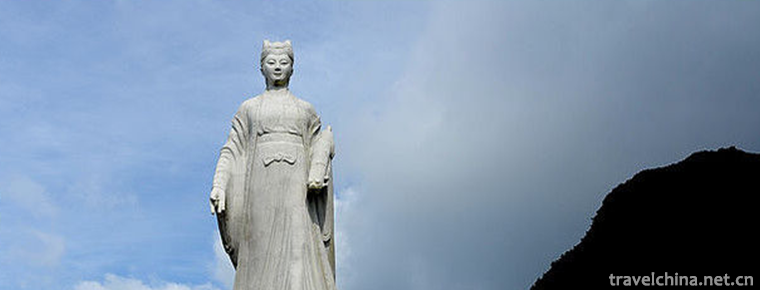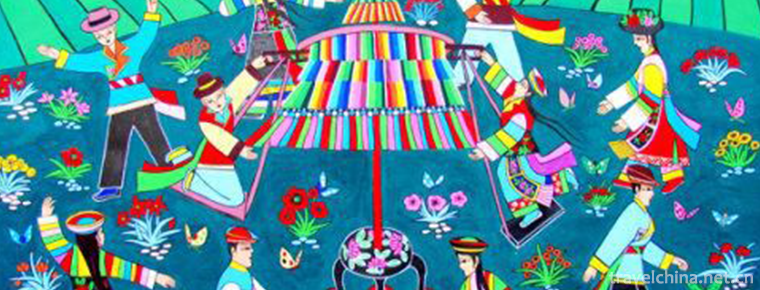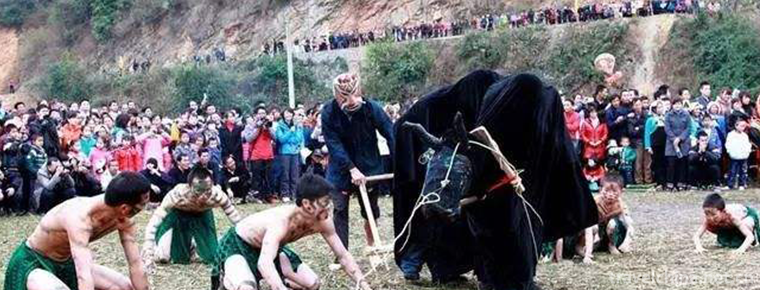Raise the Pavilion
Raise the Pavilion
Lifting the pavilion, also known as the pavilion, is a unique traditional folk dance that integrates historical stories, myths and legends, and integrates painting, opera, tie-up, paper sculpture, acrobatics and other arts.
As a kind of recreational event in Chinese folk Yingshen Competition. In the wooden square cabinet, two or three people dress up as characters in the opera story and are carried by others to parade. Yangge has been listed in the national intangible cultural heritage list. There are many kinds of elevation pavilions, and the artistic forms of elevation pavilions in different places have their own characteristics. The most famous ones are Jintan Elevation Pavilion, Huizhou Elevation Pavilion, Guangdong Elevation Pavilion, Anyang Elevation Pavilion Pavilion and Shanxi Pingyang Elevation Pavilion.
On June 7, 2008, the Cabinet was listed in the second batch of national intangible cultural heritage list with the approval of the State Council.
Word Interpretation
Lifting the cabinet is the same as "choosing the cabinet". A recreational event in the old folk Yingshen Competition.
In the wooden square cabinet, two or three people dress up as characters in the opera story and are carried by others to parade.
Shi Sheng of the Qing Dynasty, Shizhou Chunyu Shengyu, said, "The County town is looking at Marshal's meeting in April... More to the courtyard ladies, decorative embroidered cocoon painting, green and red pockets, play the story, called the elevation of the pavilion.
Lu Xun's Five Ramps Club: "Next are the so-called stilts, pavilions and horseheads, and the criminals dressed in red shackles and children in them."
historical origin
The earliest embryonic form of the pavilion was to tie up two wooden lifting poles of more than one foot long and three inches thick on both sides of a household square table, then tie up two slightly long and two inches thick crossmasts on the two ends of the lifting pole, and then tie up the lifting pole on the middle of the mast. The deity tables on the square table and sacrifices such as pigs, sheep, incense burners and candles were carried by four people to celebrate along the street to return the pavilion. Wish. With the development of the times, the prosperity of the economy and the progress of the culture, the people feel that the original method of sacrificing gods seems monotonous and unattractive, and it is not appropriate. So it was changed into a special pavilion base, which resembles a square table, but much larger than the square table. Its side length is more than 4 feet, its height is more than 3 feet, and its four corners have four three inches thick base legs. On the base, there are also ancient architectural style hall models. In the hall, there are statues, statues standing on both sides of two waitresses holding Buddhist dust. In front of the statues, there are pigs and sheep, incense burners and incense stoves. Sacrifices such as candles. There are two wooden Lifting Poles about 1 cm long and 3 inches thick on both sides of the base of the pavilion. The two ends of the lifting pole are more than 4 feet long and about 3 inches thick wooden crossmast. The two ends of the crossmast are tied with lifting poles. At this time, the number of people who lift the Pavilion increased to 8. During the activities, the front of the pavilion was also equipped with the accompaniment of Suona blowing and gongs and drums. At this time, the pavilion has the characteristics of folk literature and art from the form arrangement, which is close to the scale and style of the present pavilion.
Nanying Liucun's elevation of the pavilion experienced a long period of time and changes of the times from rise to decline, from decline to prosperity, to the Republic of China, through the continuous reform and innovation of folk artists, the elevation of the pavilion base from the original square table shape, and constantly transformed into rectangular, hexagonal and square elevation modes. The hexagonal and square forms are mostly used in the elevation of the cabinet. There are three types of elevation pavilion, namely "hall type", "market building type" and "hexagonal Pavilion type". It is modeled as "city building" and "hexagonal pavilion". The cultural content on the pavilion is not the decoration of ancient gods and sacrifices, but the characters and props of dramatic stories and folk stories. For example, "Tea Bottle Plan" drama story, the characters are Miss Gong Xiuying, maid, and the Duke Xiangdan precious, props are tea bottles and flowers and other things. The number of people carrying the cabinet has increased from 8 to 16.
Performing Form
There are various forms of elevation Pavilion performances, initially rap, then transited to the operatic style of endorsement, which can perform a complete drama story. There are more than 20 repertoires often performed by Yuncheng Raising Pavilion, such as Liang Shanbo and Zhu Yingtai, Qin Qiong's Return to the Country, Na Nao Nao Hai, Drilling Flower Sedan, Counseling the Husband, Marrying a Bride, Lai Pizi's Finding a Daughter-in-law and so on. Performing arts are also equipped with big drums, gongs, two gongs, turtle snails, cymbals and so on.
Projects Making
Projects production: first make a hexagonal table with a diameter of 4 feet, under the table with four legs more than 2 feet high, on the hexagonal table top, then install six pillars 2 meters high, and on the pillars make six beams to connect with each other, and then make a hexagonal pavilion with eaves, corners, tiles, animal heads, and around the chassis (desktop), make railings with a height of more than 1 feet around the chassis to encircle the chassis edge. 。 Two 1.5-foot lifting rods are tied to both sides of the chassis. The crossmast is tied to both ends of the lifting rod, and then the lifting rod is tied up.
Nanying Living's elevation Pavilion is mainly composed of 16 people, with more magnificent momentum than before. In the past, the elevation Pavilion in Nanying could not be rotated, and the elevation pavilion was like the iron rod in Xugou. The people on the disc could rotate. The production principle of the elevation pavilion was the same as that of the iron rod in Xugou Great Transition. A moving disc was installed on the chassis and the rotary disc was rotated by people. This improvement added to the artistic charm of the elevation Pavilion pavilion.
The pace of lifting the pavilion is basically the same as that of Xugou iron bar. Generally speaking, it moves slowly. The pace of lifting the Pavilion must be the same. Only in this way can the pavilion be lifted rhythmically up and down and the people on the pavilion be able to move their arms slowly.
Chunguang Village also has a kind of elevation pavilion, but it is different from the elevation Pavilion in Nanying. The table top of Chunguang Village's elevation Pavilion is a 3-foot square chassis, with table legs more than 2 feet high underneath. Two elevation poles like sedan poles are tied to the chassis, and a quadrangular Pavilion is installed on it, on which a young girl dressed as a classical beauty is sitting. Lifting a pavilion is like a sedan chair, a pavilion or a pavilion. Its shape is very special. Four people carry a pavilion. In the process of raising the pavilion, the frequency of up and down tremor is faster and the range is larger, but it is also different from the way of lifting the sedan chair, so this unique lifting method adds special ornamental and artistic effects to this folk literature and art. This special form and special lifting method of Chunguang Village fully reflects that folk artists should consider the effect of performance when they innovate and reform each form of literature and art. People like it, enjoy it, and entertain it. This is their ultimate goal.
Folklore Inheritance
When Liu Deng's army leaped into the Dabie Mountains in 1947, the army was stationed five hundred meters north of the present Guotun. Yang Shouren, the eleventh generation successor of the Cabinet, led the Cabinet team to five performances, which were highly praised by Liu Bocheng and Deng Xiaoping. In 1949, Yang Zhao, the twelfth generation successor of the Elevation Cabinet Team, led the team to perform more than ten performances in Dongmen Square, Yuncheng, with tens of thousands of spectators.
After the founding of the People's Republic of China, Yang Qijing, the 13th generation successor of the Elevation Court, has performed in Kaifeng, Xuzhou, Liaocheng and Jining for many times. It was suspended for ten years during the Cultural Revolution. Three pairs of elevators were smashed by the Red Guards. In 1978, Yang Yinxi and Yang Yinwen reorganized the Elevation Court performing class and led the team to Jining to perform more than 20 performances, which was warmly welcomed by the local people.
In 2005, Shaoji Village, Guotun Town, responded to the call of its superiors and built a cultural courtyard. Seeing that there were places for cultural activities, the artists in the past began to feel itchy: "Lifting the courtyard is a treasure handed down from their ancestors. Why not seize the opportunity to pick it up?" Therefore, they began to rebuild their flags and drums: they moved the shelves of the village committee which had been shelved for more than 40 years, bought drums, gongs and clothes with their own funds, selected four eight-year-old students from Shaoji Village Primary School as cabinet children, together with the village's over ten-year-old artists in recent 60 years, and a team of more than 20 actors came into being in Hancheng.
In order to carry forward the traditional culture and show the charm of the pavilion. On New Year's Day, the Yuncheng Pavilion Team toured nearby villages and ancestral temples to give a rich cultural feast to the masses. In 2011, the Yuncheng Elevation Team participated in the Water Margin Cultural and Art Exhibition on the 90th anniversary of the founding of the Party in Yuncheng County, and the large-scale mass cultural activities in the county often invited them to perform. Yang Yanzhuang, 60 years old, has been practicing raising the cabinet and performing with the team since he was 15 years old. He is now a drummer.
On September 21, 2012, in order to vigorously promote traditional festival culture and inherit excellent folk art, with the strong support of Wuyuan County Cultural Radio and Television Bureau, Jiangxi Province, Jialu Exhibition Hall was built in Jialu Village, Fuchun Town, and opened to the outside world free of charge. It is understood that the exhibition hall has invested more than 60,000 yuan. The exhibition hall contains rich and colorful art fresco exhibition boards, vivid figures, costumes, colorful utensils and other performance equipment, which integrates display and inheritance functions. Wuyuan Jialu Yangge, known as "one of the best in China", is a provincial intangible cultural heritage. There are nearly 40 traditional plays, such as Journey to the West, Legend of White Snake, Liang Shanbo's Catching Examinations. Among them, Shui Man Jinshan was awarded a gold medal at the 7th China Folk Art Festival and the "Shanhua Award" Chinese Folk Piaose (Yangge) Art Exhibition.
Tiantai County Feiyi Lieyang Pavilion blossoms everywhere:
The "Drum Pavilion" in Dongmen Village began in Tongzhi Period of Qing Dynasty and was completed by two carpenters in three years. It has a history of more than 100 years. It has exquisite shape and exquisite production, which fully reflects the superb craftsmanship of the craftsmen at that time. "Drum Pavilion" followed by more than ten folk musicians, playing "ten times" is called "ten times".
The legendary scene is reproduced in the "Nine Dragons Tower" in Hongcun, Yuhu. Legend has it that nine dragons of the Dragon King of the East China Sea pulled 72 dragon scales out of their bodies for the safety of fishermen in the East China Sea and turned them into a lotus flower with 72 petals. Later, they turned into 72 peaks, which is Tiantai Mountain.
Qiaonan Community's "New Tianxian Pair" is based on the legend of the ancient seven fairies and Dong Yong. It reflects Dong Yong, who has "no tiles on the top and no inches on the bottom", but has lived a life of fairy and beautiful family members. It implies that under the guidance of the "Chinese Dream", the broad masses of the people are quick, hard-working and prosperous, and lead a happy and happy life.
"Chang'e welcomes relatives" and "Chinese Dream" of Yangge in Donglian Village and Sifangtang Village both reproduce the scene of Chang'e 3 landing on the moon. The legend expresses the theme of "Chang'e 3 Lunar Explorer successfully landed on the moon, lonely Chang'e Shuguang sleeve, greeting relatives from her hometown" which combines with reality, and eulogizes the brilliance of the Chinese people on the journey to climb the world's scientific and technological peak.
Youming Village's "Xiaojigong Drought Dragon" was created according to "Jigong Legend". According to legend, during the Southern Song Dynasty, Tiantai suffered from severe drought. Xiao Jigong followed the water intake team to Jiulongtan to fetch water. He found that drought dragons were responsible for this. Drought dragon complained to Ji, saying that the Hawthorn that he held in the rain of Jade Emperor was robbed by the mountain hawk, so it could not rain. Xiao Jigong Sandou Mountain Badger recaptured the Jade Disk and rained happily. All the people were happy.
The "Peach Blossom Fairy" in Erli Xucun is based on the legend of Liu Ruan's encounter with fairy in Tiantai. Legend has it that Liu Chen and Ruan Zhao, two of the Han Dynasty's Taoxi Langs, went to Tiantai Mountain to collect medicines and lost their way. They met fairies to rescue them and were married in pairs.
The two immortals of harmony and harmony are vividly reproduced in the elevation Pavilion of Zidong community. "He He Er Xian" refers to the two elite monks of Tiantai Mountain in Tang Dynasty. Hanshanzi lived in seclusion in Hanshi Mountain of Tiantai, and the monks of Guoqing Temple were sympathetic. Folk people regarded them as "two immortals of harmony" and Emperor Yongzheng of Qing Dynasty as "two saints of harmony". Tiantai is the birthplace of Chinese Hehe culture.
Miaoshan Village's "Wukui of the Southern Country" reproduces the image of Chen Guifen, the first person in Guangxuwu in the Qing Dynasty. Chen Guifen, a native of Miaoshan Mountain in Tiantai, was awarded "the first prize and the first prize" for both civil and military proficiency. He also rewrote the pattern that the first prize in Wuke was a northerner. In the second year of Guangxu, he was appointed first-class bodyguard plus four ranks. Later, he was awarded to the general of Zhaoqing, Guangdong Province. He was diligent and honest, and the people presented the plaque "Deep Rain and Dew of Grace".
The "Jigong Cricket Fighting" in Liongge of Beimen Village was created according to the Tiantai folklore "Jigong Cricket Fighting". Legend has it that in the Southern Song Dynasty, carpenter Zhang Yu worked in the Prime Minister's palace and released Luo Gongzi's crickets because of curiosity. Luo Gongzi was furious and wanted Zhang Yu to pay compensation within three days, otherwise he would die. Zhang Yu was saved by Jigong when she threw herself into the river. Jigong Buddhist Dharma is boundless. He defeated the cock with a half-dead cricket and rescued the carpenter Zhang Yu.
Qinfeng Village's "Rhododendron Fairy" was created according to Tiantai Mountain folklore. According to legend, there was a black snake spirit in Huading of Tiantai Mountain, which made many evil ends and forced boys and girls every year. The girl Yunjin disguised herself as a virgin and killed the black snake spirit with a sharp knife. She was seriously injured. Where her blood spilled, the beautiful Yunjin azalea bloomed.
Qiao Shangcun's "Xiake Tour Tiantai" reappears the scene of Xu Xiake's trip to Tiantai Mountain at that time. In 1613, Xu Xiake came to Tiantai Mountains and wrote the Journal of Touring Tiantai Mountains, which was marked at the beginning of Xu Xiake's Travel Notes.
The "Qilin Dance" in Xingzhuang Village started in Ming Dynasty. Qilin is the symbol of auspiciousness. Qilin Dance is a traditional performance item of Lantern Festival. Boys dress up as the champion yuan, the God of wealth, the Queen Star, the prime minister and the flower detector stand on the shoulders of adults. According to the rhythm of gongs and drums, they break down and run round. It expresses people's wishes for a prosperous New Year, happiness and well-being of the people, and enthusiastically eulogizes today's peaceful prosperity and national peace.
Such a large number of elevated pavilions are eye-catching, reflecting the vastness and profundity of Tiantai Mountain culture.
Historical Stories
During the Qing Dynasty, Li Zhongtang, a Beijing official, visited the people in Yuncheng and passed through the village entrance of Shaoji. It happened that the villagers carried out a pavilion-raising performance, and the women in the pavilion were dancing like Fairies in the air. Li Zhongtang, sitting in a sedan chair, was dazed. He thought, "It's amazing that I've traveled all over China, and I've never seen such a form of singing before." So the sedan chair was asked, and the inscription was sent to the plaque after watching, saying, "All over the territory, there is no unique occasion", and the inscription of female performers folding fan was sent to the world, and the inscription of male performers folding fan was sent to the world, and the suggestion of raising the cabinet for performance was put forward, that is, a pair of lifting the cabinet for parallel performance, which later developed into many pairs of performances.

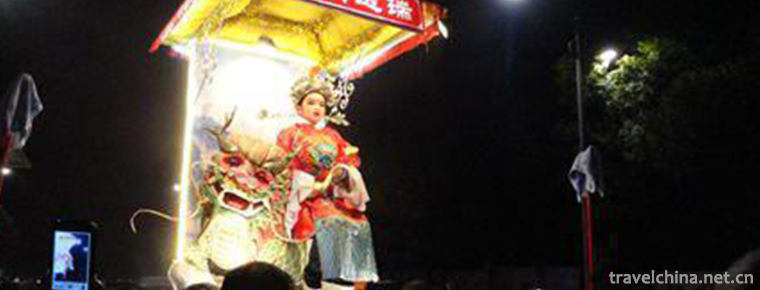
-
Mount Huangshan
Huangshan: World Cultural and Natural Heritage, World Geopark, National AAAAA Class Scenic Spot, National Scenic Spot, National Civilized Scenic Spot Demonstration Site, Top Ten Famous Mountains....
Views: 235 Time 2018-10-28 -
White cut chicken
White cut chicken, also known as white cut chicken, is the most common dish in Guangdong cuisine. It is a kind of chicken dipping. Its characteristics are simple and easy to prepare, without batching .
Views: 232 Time 2018-11-02 -
Shanghai Metropolitan Vegetable Garden
Shanghai Metropolitan Vegetable Garden is located on the Bank of Hangzhou Bay, Bay Town, Fengxian District. It is about 50 kilometers away from the center of Shanghai.
Views: 305 Time 2018-12-19 -
Legend of Cang Jie
Cangjie Legend is an ancient Chinese folklore. The story of Cangjie's writing originated from the Yan and Huang Dynasties and has a history of 5,000 years. Legend has it that in .
Views: 183 Time 2019-04-04 -
Guilin fishing drum
Guilin fishing drum, commonly known as sentiment, is the local traditional rap and singing art of Guilin. The Song Dynasty was introduced into Guilin from the north, .
Views: 145 Time 2019-05-02 -
Jianchuan Opera
Jianchuan Baiqu is an ancient music variety with a long history and wide spread in Bai nationality area. It is mainly popular in Jianchuan, Eryuan and Tongdian, Jinding and Jiuhe of Lanping County, Nu.
Views: 309 Time 2019-05-05 -
Ma Xian Xing custom
The belief in Ma Xian is a traditional folk custom inherited from generation to generation by the people of Fujian and Zhejiang. Ma Xian, also known as Ma Xiaoxian, is a goddess worshipped in northeas.
Views: 383 Time 2019-05-16 -
Turkish Pan Embroidery
Pan embroidery is the most important embroidery method in Chinese Tu embroidery, and it is a compulsory course for Tu women in their lifetime. Pan embroidery is a unique embroidery method of the Tu na.
Views: 388 Time 2019-06-23 -
Add another festival beside the word ants of the Zhuang nationality
The Zhuangs Ant Festival (insect word plus another) is mainly prevalent in the Hongshui River Basin in the northwest of Guangxi Zhuang Autonomous Region. It is named "Ant (insect word plus anothe.
Views: 178 Time 2019-08-16 -
Social security in Deyang
In 2018, there were 748000 employees participating in basic endowment insurance, 345000 in unemployment insurance, 752000 in medical insurance, 384000 in industrial injury insurance and 399000 in maternity insurance. In the whole year,.
Views: 338 Time 2020-12-14 -
Mianyang tertiary industry
In 2019, the added value of the tertiary industry in Mianyang will increase by 9.4%, 0.9 percentage points higher than the average level of the whole province. Among them, the added value of wholesale and retail industry increased by 9.5%, transportation.
Views: 330 Time 2020-12-14 -
Meishan primary industry
In 2019, the total sown area of crops is 318000 hectares, an increase of 1.1%. Among them, the planting area of grain crops was 196000 hectares, an increase of 0.6%; the planting area of oil crops was 58000 hectares, an increase of 1.8%; the planting area .
Views: 333 Time 2020-12-18
